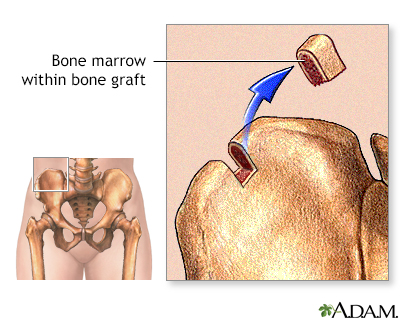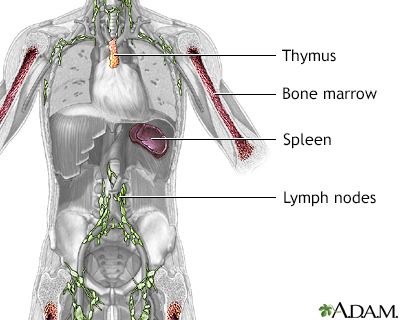Acute lymphoblastic leukemia (ALL)
ALL; Acute lymphoblastic leukemia; Acute lymphoid leukemia; Acute childhood leukemia; Cancer - acute childhood leukemia (ALL); Leukemia - acute childhood (ALL); Acute lymphocytic leukemia
Acute lymphoblastic leukemia (ALL) is a fast-growing cancer of a type of white blood cells called lymphocytes.
ALL occurs when the bone marrow produces a large number of immature lymphoblasts, a cancerous form of lymphocytes. Bone marrow is the soft, spongy tissue found inside most bones in children and in the front chest bone (sternum) and the pelvis bones in adults that helps form all blood cells. The abnormal lymphoblasts grow quickly and replace normal cells in the bone marrow. ALL prevents healthy blood cells from being made. Life-threatening symptoms can occur as normal blood counts drop.

A small amount of bone marrow is removed during a bone marrow aspiration. The procedure is uncomfortable, but can be tolerated by both children and adults. The marrow can be studied to determine the cause of anemia, the presence of leukemia or other malignancy, or the presence of some storage diseases, in which abnormal metabolic products are stored in certain bone marrow cells.

This picture shows the darkly-stained lymph cells (lymphoblasts) seen in acute lymphocytic leukemia (ALL), the most common type of childhood leukemia.

Note multiple Auer rods which are found only in acute myeloid leukemias, either myeloblastic or monoblastic. These rods consist of clumps of azurophilic granule material.

Bone marrow may be harvested from the hip (iliac bone) to serve as bone grafts elsewhere in the body.

The immune system protects the body from potentially harmful substances. The inflammatory response (inflammation) is part of innate immunity. It occurs when tissues are injured by bacteria, trauma, toxins, heat or any other cause.
Causes
Most of the time, no clear cause can be found for ALL.
The following factors may play a role in the development of all types of leukemia:
- Certain chromosome problems
- Exposure to radiation
- Past treatment with chemotherapy medicines
- Receiving a bone marrow transplant
- Toxins, such as benzene
The following factors are known to increase the risk for ALL:
- Down syndrome or some other genetic conditions
- A brother or sister with leukemia
This type of leukemia usually affects children ages 3 to 7. ALL is the most common childhood cancer, but it can also occur in adults.
Symptoms
ALL makes a person more likely to bleed and develop infections. Symptoms include:
- Bone and joint pain
- Easy bruising and bleeding (such as bleeding gums, skin bleeding, nosebleeds, abnormal periods)
- Feeling weak or tired
- Fever
- Loss of appetite and weight loss
- Paleness
- Pain or feeling of fullness below the ribs from an enlarged liver or spleen
- Pinpoint red spots on the skin (petechiae)
- Swollen lymph nodes in the neck, under arms, and groin
- Night sweats
These symptoms can occur with other conditions. Talk to your health care provider about the meaning of specific symptoms.
Exams and Tests
Your provider will perform a physical exam and ask about your symptoms.
Blood tests may include:
- Complete blood count (CBC), including white blood cell (WBC) count and cell differential
- Platelet count
- Bone marrow biopsy
- Lumbar puncture (spinal tap) to check for leukemia cells in the spinal fluid
Tests are also done to look for changes in the DNA inside the abnormal white cells. Certain DNA changes may determine how well a person does (prognosis), and what kind of treatment is recommended.
Treatment
The first goal of treatment is to get blood counts back to normal. If this occurs and the bone marrow looks healthy under the microscope, the cancer is said to be in remission.
Chemotherapy is the first treatment tried with the goal of achieving a remission.
- The person may need to stay in the hospital for chemotherapy. Or it may be given at a clinic and the person goes home afterward.
- Chemotherapy is given into the veins (by IV) and sometimes into the fluid around the brain (the spinal fluid). Oral chemotherapy may be given after a remission to maintain it.
After a remission is achieved, more treatment is given to achieve a cure. This treatment can include more IV chemotherapy or radiation to the brain. Stem cell or bone marrow transplant from another person may also be done. Further treatment depends on:
- Age and health of the person
- Genetic changes in the leukemia cells
- How many courses of chemotherapy it took to achieve remission
- If abnormal cell DNA is detected in the bone marrow after remission
- Availability of donors for stem cell or bone marrow transplant
You and your provider may need to manage other concerns during your leukemia treatment, including:
- Having chemotherapy at home
- Managing your pets during chemotherapy
- Bleeding problems
- Dry mouth
- Eating enough calories
- Safe eating during cancer treatment
Support Groups
You can ease the stress of illness by joining a cancer support group. Sharing with others who have common experiences and problems can help you not feel alone.
Outlook (Prognosis)
Those who respond to treatment right away tend to do better. Most children with ALL can be cured. Children often have a better outcome than adults.
Possible Complications
Both leukemia itself and the treatment can lead to many problems such as bleeding, weight loss, and infections.
When to Contact a Medical Professional
Contact your provider if you or your child develops symptoms of ALL.
Prevention
The risk for developing ALL may be reduced by avoiding contact with certain toxins, radiation, and chemicals.
References
National Cancer Institute website. Adult acute lymphoblastic leukemia treatment (PDQ) - health professional version.
National Cancer Institute website. Childhood acute lymphoblastic leukemia treatment (PDQ) - health professional version.
Pillai PM, Carroll WL. Acute lymphoblastic leukemia. In: Fish JD, Lipton JM, Lanzkowsky P, eds. Lanzkowsky's Manual of Pediatric Hematology and Oncology. 7th ed. Philadelphia, PA: Elsevier; 2022:chap 18.
Version Info
Last reviewed on: 2/2/2023
Reviewed by: Mark Levin, MD, Hematologist and Oncologist, Monsey, NY. Review provided by VeriMed Healthcare Network. Internal review and update on 07/17/2024 by David C. Dugdale, MD, Medical Director, Brenda Conaway, Editorial Director, and the A.D.A.M. Editorial team.
